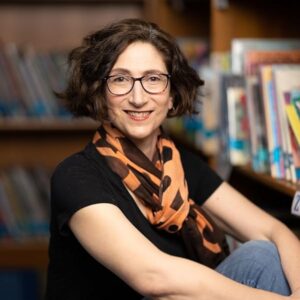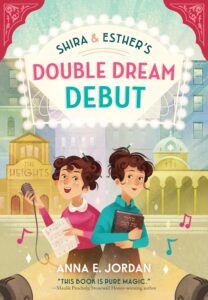In Anna E. Jordan’s middle grade book SHIRA & ESTHER’S DOUBLE DREAM DEBUT (Chronicle Books, 2023), look-alike thirteen-year-olds Shira and Esther concoct a plan to swap places when they discover they are living each other’s dreams: one girl wants to be a Bat Mitzvah, while the other has aspirations to be a performer. But when they enact the switch, Shira and Esther discover what it takes to stay true to themselves and follow their passions and dreams. SHIRA & ESTHER’S DOUBLE DREAM DEBUT is a delightful novel full of Jewish culture, traditions, family, and friendship. I look forward to learning more about the book and Anna’s writing and research process. Welcome, Anna!
Your new book, SHIRA & ESTHER’S DOUBLE DREAM DEBUT, has a unique setting reflecting significant Jewish communities. Can you share a bit about how you chose the time and place of your book?
Idylldale is the fictional town where Shira and Esther live. Shira’s part of Idylldale was inspired by the resorts and rental cabin communities in towns that dotted upstate New York. This area, called the Borscht Belt, was developed for Jewish recreation when other establishments wouldn’t allow Jews. My connection to the Borscht Belt is through my mother (now 85) who spent her summers in Ellenville with my great-aunt and worked at the local soda fountain. I’m also a huge “Dirty Dancing” fan. Esther’s part of Idylldale is based on the tenements, small storefronts, and peddler’s carts of the Lower East Side of Manhattan. In addition to Esther’s beloved Yiddish theater, The Heights, there are delis and a kosher Chinese Restaurant.
This mashup of place is also a mashup of time. The heyday of the Borscht Belt was popular from 1920-1960s. In the 50s through 70s, many of them went out of business and closed. The Yiddish theater in America was a place for turn-of-the-century immigrants to find a linguistic and cultural home, but they too closed with a decline in Jewish immigration after WWI around the Depression.

Your plot is a fun twist on a classic twin swap. How did you develop the plot for Shira and Esther?
Who doesn’t love a switched-identities plot?!? While most people immediately picture “Parent Trap,” I used the classic PRINCE AND THE PAUPER, by Mark Twain, as the model text. However, the seed of the idea wasn’t from any existing story, it was from a person–the real Benjamin Zuckerman. On a visit to the Society of Illustrators in NYC, I viewed an exhibit of Drew Friedman’s drawings from his book JEWISH COMEDIANS. One of the museum title cards explained that Benjamin Zuckerman was a comedic songwriter but his father wanted him to be a Rabbi. I thought, what if two people wanted what the other had, and their parents each wanted the opposite? The story flowed from there.
You chose an unusual omniscient narrator for the story, which really sets the tone for the back-and-forth antics. How did this creative choice evolve?
The narrator’s voice was one of the first that came to me, but it wasn’t an easy sell. While the storyteller’s voice isn’t unusual in middle grade (think Kate DiCamillo’s, THE TALE OF DESPEREAUX) having a named adult tell the story is less common in modern children’s literature. I’m grateful that my first editor, Taylor Norman, saw the potential and purpose of the choice. She not only embraced it but throughout our work together, the narrator’s love of food was amplified in metaphor and word choice in the writing. This type of narrator also embodies the oral tradition of Jewish culture: think of Passover. To inform my writing, I read translations of Sholom Alechem and other Yiddish short stories.
You include many cultural and historic details in the book, from synagogue to Yiddish theatre, delis, and more. What was our research process like? Did you discover any fun or interesting facts that didn’t make it into the book?
Some of my favorite research had to do with Esther’s side of Idylldale. I was lucky to visit the Tenement Museum and the Museum at Eldridge Street. I had to try various delis and knishes (of course!) which led me from Parkway Deli in DC to Russ and Daughters and Yonah Schimmels Knishery in NYC. There’s currently an exhibition about Jewish Delis (“I’ll Have What She’s Having”) that I didn’t get to enjoy while I was writing the book. I’m so glad it’s just opened here in DC at the new Capital Jewish Museum! (May 15- August 20)
Additionally, I took a class on Yiddish theater through YIVO and improved my religious Jewish Knowledge by taking a “12 Jewish Questions” class at my synagogue. I read GROWING UP AT GROSSINGER’S, by the daughter of the Grossinger’s resort owner and many other books about Jewish comedy. There’s a ton of wonderful information about the Borscht Belt that I learned through the Borscht Belt Tattler Podcast from Jen Stewart. I’m thrilled that now I have my own episode where we chat about the book!
Specifics about history, setting, and comedic performances going on at the resort slowed down the story and ultimately ended up on the editing floor. I hated losing the line I wrote about the pounds of laundry and other housekeeping that got done at Grossinger’s.

Which character most reflects you – Shira or Esther?
Both characters have bits of me. Shira is the stage-loving/creative side of me. Like Esther, I’m happiest with my nose in a book. She embodies my interest in learning more about the positive aspects of Judaism. So much of my Jewish learning as a child had to do with oppression and hatred. While researching this book, I relished the chance to immerse myself in Jewish Joy!
Thank you, Anna!
Anna E. Jordan, an author and middle grades educator, was the recipient of the 2013 PEN New England Susan P. Bloom Children’s Book Discovery award and has an MFA from the Writing for Children and Young Adults program at Vermont College of Fine Arts. SHIRA AND ESTHER’S DOUBLE DREAM DEBUT (Chronicle Books, 10/10/23) is her first novel. In addition to THIS PUP STEPS UP, her poems appear in the anthology THE PROPER WAY TO MEET A HEDGEHOG AND OTHER HOW TO POEMS (Candlewick, 2019). You can also find her work national magazines including Ladybug, Babybug, Highlights High Five, Coxing Magazine, and Maine Women Magazine. Follow Anna on Twitter and Instagram @annawritedraw or on her blog Creative Chaos.